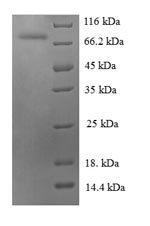The Recombinant Human Heat shock 70 kDa protein 6 (HSPA6) is expressed in E. coli and features a partial sequence from the 1-637 amino acid region. This protein comes with an N-terminal 6xHis-tag, which makes purification and detection more straightforward in research applications. It reaches a purity greater than 90%, as verified by SDS-PAGE, which appears to ensure high-quality results for experimental use. This product is intended for research purposes only.
HSPA6 belongs to the heat shock protein 70 family, which may play a crucial role in cellular stress response mechanisms. It acts as a molecular chaperone, helping with the proper folding of nascent and stress-accumulated proteins while preventing protein aggregation. The study of HSPA6 seems important for understanding cellular homeostasis and stress response pathways. This makes it a potentially valuable tool in research focused on protein folding and stress conditions.
Potential Applications
Note: The applications listed below are based on what we know about this protein's biological functions, published research, and experience from experts in the field. However, we haven't fully tested all of these applications ourselves yet. We'd recommend running some preliminary tests first to make sure they work for your specific research goals.
Based on the provided information, recombinant human HSPA6 is produced in an E. coli expression system as a partial protein fragment (1-637aa) with an N-terminal 6xHis-tag. HSPA6 is a member of the HSP70 heat shock protein family that requires precise domain folding, ATP-binding capability, and proper conformational changes for its chaperone functions. While E. coli can express some eukaryotic proteins successfully, the complex folding requirements and functional domains of HSP70 family proteins present significant challenges. The "partial" length designation is concerning, as full-length HSPA6 is approximately 643 amino acids, suggesting this construct may lack critical C-terminal residues important for function. Therefore, the protein's folding status and bioactivity cannot be confirmed and should be considered unverified.
1. Heat Shock Response Mechanism Studies
This application requires validation of protein functionality. If correctly folded and functional, recombinant HSPA6 could be used to study heat shock response mechanisms and protein-protein interactions with other chaperones. However, if misfolded or inactive (unverified), interaction studies would yield biologically irrelevant results that do not reflect true HSPA6 functions in cellular stress responses. The partial nature of the protein raises concerns about domain integrity essential for proper interactions.
2. Antibody Development and Validation
This application is suitable regardless of folding status. The recombinant HSPA6 can serve as an effective antigen for antibody generation, as antibodies primarily recognize linear epitopes. The high purity reduces cross-reactivity issues, and the His-tag facilitates purification and immobilization for antibody screening. However, antibodies generated against a potentially misfolded protein may not optimally recognize conformation-dependent epitopes of native HSPA6 in biological contexts.
3. Protein Folding and Chaperone Activity Assays
This application carries a high risk without functional validation. If properly folded and active, the protein could be used to study chaperone functions in protein refolding assays. However, if misfolded or inactive (likely without validation), such assays would produce invalid results regarding HSPA6's chaperone capabilities. The partial nature of the protein may compromise essential functional domains required for substrate binding and refolding activity.
4. Structural and Biophysical Characterization
This application requires proper folding validation. If correctly folded, the protein could be used for structural studies to understand HSPA6's architecture. However, if misfolded, structural data would misrepresent the native protein's conformation. The partial nature of the construct and presence of the His-tag may interfere with crystallization or yield structures not representative of full-length functional HSPA6.
5. Pull-down Assays for Interaction Partner Identification
This application is high-risk without folding verification. If properly folded, His-tagged HSPA6 could identify genuine interaction partners. However, if misfolded, the protein may exhibit non-specific binding or fail to recognize true biological partners, leading to misleading interaction data. The partial nature of the protein may lack domains essential for proper partner recognition.
Final Recommendation & Action Plan
This recombinant HSPA6 should be considered high-risk for functional studies due to its partial nature, expression in E. coli, and lack of folding/activity validation. Before any application, rigorous validation of protein folding and functionality must be performed using ATPase activity assays, client protein binding tests, and biophysical characterization (circular dichroism, size-exclusion chromatography). For reliable results, consider using full-length HSPA6 expressed in eukaryotic systems better suited for proper chaperone folding, and always include appropriate positive controls in experiments. Antibody development can proceed with the understanding that resulting antibodies may require additional validation for native protein recognition.






